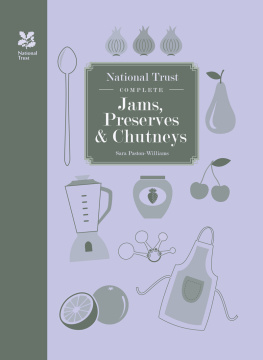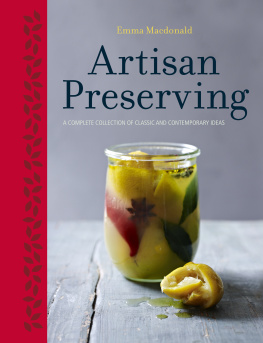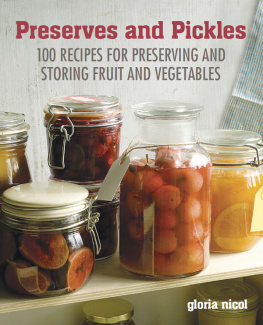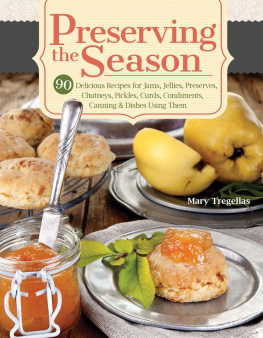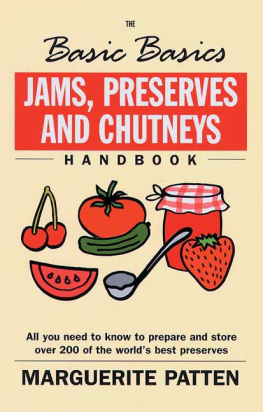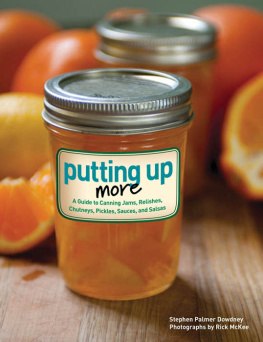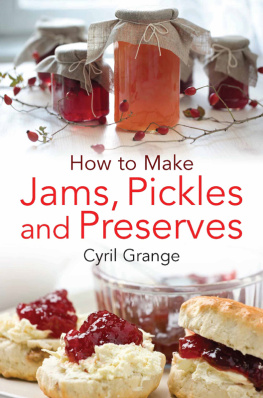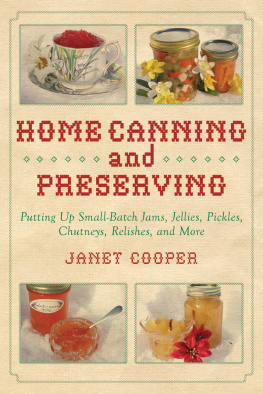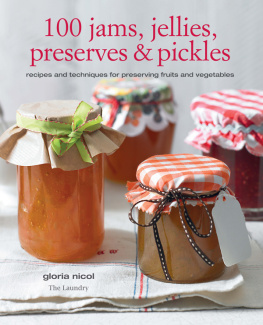COMPLETE
Jams, Preserves
AND Chutneys
COMPLETE
Jams, Preserves
AND Chutneys
Sara Paston-Williams

Contents
Introduction
There are few activities more enjoyable than making your own preserves. As modern life moves faster and faster, it is easy to lose sight of the good things in life: the perfume of bubbling fruit, the glistening of a pot of hedgerow jelly and the crisp bite of a homemade pickled onion. Whether you are an experienced cook or rarely approach the stove, making preserves especially chutneys is not difficult and the results are so much better than anything you can buy.
It is also very satisfying to know that you are following in the footsteps of centuries of country housewives who have preserved seasonal foodstuffs to enjoy throughout the year. Before fridges and freezers, fruits, vegetables and herbs were dried, preserved in honey and sugar, or spiced in vinegar. Nuts were stored in wet salt or buried in dry earth, while eggs were pickled, or waxed and buried in sand or sawdust. Scents, flavourings and essences from fruits, nuts, herbs and flowers were distilled and sealed in flasks, while vegetables, flowers, fruits and herbs produced a variety of wines and drinks.
The great country houses had a special still-room, where the lady of the house supervised the making of preserves and sweetmeats for the dessert course and the distilling of medicines and perfumes. Several of these early still-rooms survive in National Trust houses: Ham House near Richmond is Surrey is a good example. Their laboratory character gave way to a more conventional kitchen style in the eighteenth century, but the idea that these were places where luxury items were made continued. Usually the still-room was in the housekeepers part of the house, rather than the cooks. Here jams, jellies, syrups and sauces, and the newly fashionable chutneys and pickles, were made and kept under lock and key. Good examples of nineteenth-century still-rooms can be seen at Uppark and Petworth, both in Sussex, and at Tatton Park in Cheshire.
These arrangements were echoed right down the social scale, so that the humblest cottage might boast a jam cupboard, using the rich harvests of summer to brighten the dull culinary months, and to provide foodstuffs such as pickled damsons, rhubarb jam and quince cheese for the celebration of Christmas and other special occasions.
My family are addicted to making preserves. We all have our own speciality, but agree that it is worth investing in a good-quality stainless-steel preserving pan. A sugar thermometer and a jam funnel are useful, but not essential. All other necessary items are everyday pieces of kitchen equipment.
Although preserving is not difficult, it is important to remember some basic rules about hygiene. Bottles, jars and lids must be clean, free of cracks, and sterilised before use, to prevent the growth of moulds and yeasts. Always pot preserves straight from the pan or totally cold: never when just hot or warm, because this will lead to condensation and mould on the preserve.
To sterilise jars, bottles and lids
Wash in hot, soapy water or the dishwasher, making sure that there is no residue on them, and then rinse thoroughly in hot water. Sterilise using one of the following methods:
Stand the jars or bottles and lids right-side up on a wire rack in a large pan, making sure that they do not touch each other or the sides of the pan. Cover completely with water and then bring to the boil. Simmer for 10 minutes and then remove from the water and stand upside down on a clean, thick cloth to drain. Dry completely in a pre-heated oven at 110C, 225F, gas mark , right-side up, on a baking sheet for about 15 minutes. They can be kept warm in the oven until required.
Heat the oven to 180C, 350F, gas mark 4. Stand the jars, bottles and lids on the oven shelf and leave for 10 minutes to sterilise. Turn the oven off and keep them warm until ready to fill.
If your dishwasher has a very hot cycle, you can sterilise your jars, bottles and lids in that.
Conversions
Weight | Liquid measure | Length | Temperature |
15g (oz) | 30ml (1fl oz) | 5mm (in) | 110C, 225F, gas mark |
25g (1oz) | 100ml (3fl oz) | 1cm (in) | 120C, 250F, gas mark |
40g (1oz) | 150ml (5fl oz or pint) | 1.5cm (in) | 140C, 275F, gas mark 1 |
50g (1oz) | 200ml (7fl oz or pint) | 2cm (in) | 150C, 300F, gas mark 2 |
85g (3oz) | 250ml (9fl oz) | 2.5cm (1in) | 160C, 325F, gas mark 3 |
100g (3oz) | 300ml (10fl oz or pint) | 5cm (2in) | 180C, 350F, gas mark 4 |
175g (6oz) | 350ml (12fl oz) | 190C, 375F, gas mark 5 |
225g (8oz) | 400ml (14fl oz) | 200C, 400F, gas mark 6 |
300g (10oz) | 450ml (16fl oz or pint) | 220C, 425F, gas mark 7 |
350g (12oz) | 600ml (20fl oz or 1 pint) | 230C, 450F, gas mark 8 |
400g (14oz) | 850ml (1 pints) | 240C, 475F, gas mark 9 |
450g (1lb) | 1 litre (1 pints) | These approximate conversions are used throughout this book. Please follow either metric or imperial measurements for the correct proportions. |
700g (1lb) | 1.2 litres (2 pints) |
900g (2lb) | 2 litres (3 pints) |
1.35kg (3lb) | 3 litres (5 pints) |
1.8kg (4lb) | 4.2 litres (7 pints) |
2.75kg (6lb) | 5 litres (9 pints) |
Chutneys, Relishes and Sauces

Nothing livens up simple food like a chutney, relish or ketchup. They are all oriental in origin chutney coming from the Hindustani word chatni meaning a strong, sweet relish and ketchup derived from the Chinese koe-chiap, a pickled fish sauce and first appeared in Britain at the end of the seventeenth century as a result of increased trade through the East India Company.
Chutneys and ketchups continued to exist in their oriental form until the nineteenth century, when the fashion-conscious cooks of British families started to make their own based on the exotic oriental recipes, cooking green peaches, mangoes and bananas with onions, garlic and chillies, and then mixing with smoked fish, spices, olive oil and vinegar. As the taste for chutneys and ketchups developed, the oil was omitted and sugar was added.
The use of home-grown produce, such as plums, apples, and particularly tomatoes, became popular; we could not imagine life today without tomato sauce or ketchup. Generally, chutneys and ketchups became much blander and sweeter and remained so until relatively recently. Now once again we seem to be enjoying spicier and hotter preserves, as part of our love affair with the chilli pepper.
Many National Trust restaurants and tea rooms make their own excellent chutneys and relishes from vegetables and fruit grown in the kitchen gardens of historic houses, on the surrounding estate, or sourced from local farms or market gardens.
Next page
